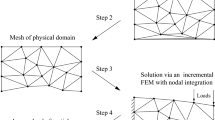Abstract
This paper presents a numerical technique for the analysis of the cone penetration test by means of the commercial finite element code ABAQUS. The von Mises yield criterion with its associated flow rule is assumed to model the plastic behaviour of elastoplastic undrained clays. An explicit finite element scheme is used to efficiently perform a large number of loading increments and to simplify the treatment of contact. An Arbitrary Langrangian–Eulerian (ALE) scheme is adopted to preserve the quality of mesh throughout the numerical simulation. A volumetric weighting algorithm adjusts the relative positions of nodes after each loading increment. This prevents mesh over distortion and allows the simulation to run continuously. The variation of the cone resistance is examined in relation to various parameters such as the in situ stress state, shaft and cone face roughness, and the material strength when steady state conditions have been reached. The trends of these variations are highlighted and compared with those found by other researchers. This technique can be extended to analyse the plastic behaviour of elastoplastic sands often modelled using either the Drucker–Prager yield criterion or a critical state model.


















Similar content being viewed by others
References
Abu-Farsakh M, Tumay M, Voyiadjis G (2003) Numerical parametric study of.piezocone penetration test in clays. Int J Geomech 3(2):170–181
Baligh MM (1985) Strain path method. J Geotech Eng, ASCE 111(3):1108–1136
Belytschko T, Bindeman LP (1993) Assumed strain stabilization of the eight node hexahedral element. Comp Methods in Appl Mech Eng 105:225–260
Benson DJ (1992) Momentum advection on a staggered mesh. J of Comput Phys 100:143–162
Budhu M, Wu CS (1992) Numerical analysis of sampling disturbances in clay soils. Int J Numer Anal Methods in Geomech 16:467–492
Cheng JH (1988) Automatic adaptive remeshing for finite element simulation of forming processes. Int J Numer Methods in Eng 26:1–18
Cividini A, Gioda G (1988) A simplified analysis of pile penetration. Proc 6th Int Conf on Numer Methods in Geomechanics, pp 1043–1049
De Borst R, Vermeer PA (1984) Finite element analysis of static penetration tests. Geotechnique 34(2):199–210
Engelmann BE, Whirley RG (1990) A new explicit shell element formulation for impact analysis. In: Kulak RF, Schwer LE (eds) Computational aspects of contact, impact and penetration. Elmepress International
Flanagan DP, Belytschko T (1981) A uniform strain hexahedron and quadrilateral with orthogonal hourglass control. Int J Numeric Methods in Eng17:679–706
Haar von Karman Th (1909) Nachr Ges WissGöttingen Math-Phys Kl 204
Houlsby GT, Wheeler AA, Norbury J (1985) Analysis of undrained cone penetration as a steady flow problem. Proceedings of the fifth International Conference on Numerical Methods in Geomechanics 4:1767–1773
Hu Y, Randolph MF (1998) A practical numerical approach for large deformation problems in soil. Int J Numeric Anal Meth Geomech 22(5):327–350
Huetink J (1982) Analysis of metal forming process based on a combined Eulerean-Lagrangean finite element formulation. Proceedings of the International Conference on Numerical Methods for Industrial Forming Processes, Pineridge, Swansea, U.K, pp 501–509
Huetink J (1986) On the simulation of thermomechanical forming processes. PhD Thesis University of Enschede, The Netherlands
Kiousis PD, Voyiadis GZ, Tumay MT (1988) A large strain theory and its application in the analysis of the cone penetration mechanism. Int J Numeric Anal Methods Geomech12:45–60
Lee NS, Bathe KJ (1994) Error indicators and adaptive remeshing in large deformation finite element analysis. Finite element analysis in design 16:99–139
Lu Q (2003) A numerical study of penetration resistance in clay. PhD Thesis, The University of Western Australia
Lunne T, Robertson PK, Powell JJM (1997) Cone penetration testing. E&FN Spon, London
Puso MA (2000) A highly efficient enhanced assumed strain physically stabilized hexahedral element. Int J Numeric Methods in Eng49:1029–1064
Sheng D, Axelsson K, Magnusson O (1997) Stress and strain fields around a penetrating cone. Proceedings of the sixth International Symposium on Numerical Models in Geomechanics. NUMOG-VI (Montreal, Canada), pp 456–465
Shield RT (1955b) On the plastic flow of metals under conditions of axial symmetry. Proceedings of the Royal Society for Maths and Physics 233(A):267–287
Teh CI, Houlsby GT (1991) An analytical study of the cone penetration test in clay. Geotechnique 41(1):17–34
Van den Berg P (1994) Analysis of soil penetration, PhD Thesis, Delft University
Van Leer B (1977) Towards the ultimate conservative difference scheme III. Upstream-centred finite-difference schemes for ideal compressible flow. J of Comput Phys 23:263–275
Vesic AS (1972) Expansion of cavities in an infinite soil mass. J Soil Mech Found Div ASCE 98:265–290
Wroth CP (1984) The interpretation of in situ soil test. 24th Rankine lecture, Geotechnique 1984 34(4):449–489
Yu HS (2000) Cavity expansion methods in Geomechanics. Kluwer, Dordrecht
Yu HS (2004) In situ soil testing: From mechanics to interpretation. First James K. Mitchell Lecture, Proc ISC-2 on Geotechnical and Geophysical Site Characterization, Viana da Fonseca & Mayne, 2004 Millpress, Rotterdam, 1:3–38
Yu HS, Mitchell JK (1998) Analysis of cone resistance: review of methods. J Geotech and Geoenvironment Eng, ASCE 124(2):140–149
Yu HS, Whttle AJ (1999) Combining strain path analysis and cavity expansion theory to estimate cone resistance in clay. Unpublished Notes
Yu HS, Herrmann LR, Boulanger RW (2000) Analysis of steady cone penetration in clay. J Geotech Geoenvironment Eng, ASCE 126(7):594–605
Acknowledgements
The authors would like to thank Dr. Huaxiang Li of the Nottingham Centre for Geomechanics for his valuable assistance during the course of this work.
Author information
Authors and Affiliations
Corresponding author
Rights and permissions
About this article
Cite this article
Walker, J., Yu, H.S. Adaptive finite element analysis of cone penetration in clay. Acta Geotech. 1, 43–57 (2006). https://doi.org/10.1007/s11440-006-0005-9
Received:
Accepted:
Published:
Issue Date:
DOI: https://doi.org/10.1007/s11440-006-0005-9




